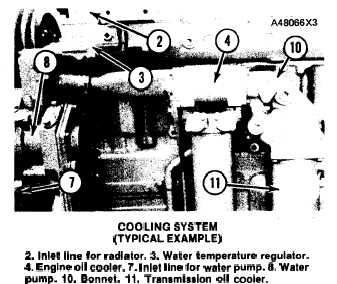TM 5-3805-258-24-1
E N G I N E
C O O L I N G
S Y S T E M
S Y S T E M S O P E R A T I O N
cooling system again. The coolant from internal
bypass (9) also works to prevent cavitation (air
bubbles) in the coolant. When the coolant gets to
the correct temperature, water temperature regula-
tor (3) opens and coolant flow is divided. Most of
the coolant goes through the radiator (1) for cooling.
The remainder goes through intenal bypass (9) to
water pump (8). The amount of the two flows is
controlled by water temperature regulator (3).
COOLING SYSTEM
(TYPICAL EXAMPLE)
2. Inlet line for radiator. 3. Water temperature regulator.
4. Engine oil cooler. 7. Inlet line for water pump. 8. Water
pump. 10. Bonnet. 11. Transmission 011 cooler.
NOTE: The water temperature regulator is an im-
portant part of the cooling system. It divides coolant
flow between the radiator (1) and the internal bypass
(9) as necessary to maintain the correct operating
temperature. If the regulator is not installed in the
system, there is no mechanical control and most of
the coolant will follow the path of least resistance
thru the internal bypass (9). This will cause the en-
gine to overheat in hot weather. In cold weather,
even the small amount of coolant that goes thru the
radiator (1) is too much and the engine will not get
to normal operating temperature.
The internal bypass (9) has another function
when the cooling system is being filled. It lets the
coolant go into cylinder head (5) and cylinder block
(6) without going through water pump (8).
Radiator (1) has a pressure relief cap and filler
cap. The pressure relief cap keeps the pressure in
the cooling system from getting too high when the
engine is running. It also lets air come into the sys-
tem when the pressure in the system is less than
atmospheric.
COOLING SYSTEM COMPONENTS
Water Pump
The centrifugal-type water pump has two seals.
One prevents leakage of water and the other pre-
vents leakage of lubricant.
An opening in the bottom of the pump housing
allows any leakage at the water seal or the rear
bearing oil seal to escape.
Fan
The fan is driven by two V-belts, from a pulley
on the crankshaft. Belt tension is adjusted by mov-
ing the alternator.
Radiator
Some models are equipped with a radiator that
has individual core sections. Each section can be
replaced separately if damaged.
3-16


